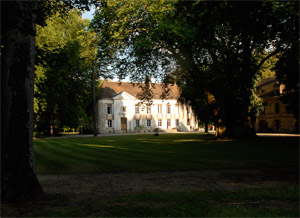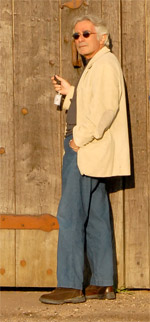
Grandsard [3], PhD

Introduction: trauma and therapy
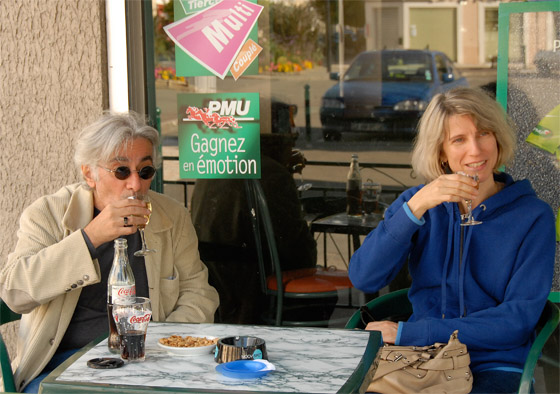
![]() Turning back to trauma as a psychopathological category, interestingly,
it is the only mental disorder for which an external cause is clearly
identified in the form of a specific type of event experienced directly
or simply witnessed by the patient[7] .
However, as such, it poses a methodological challenge to psychopathology
research and theory. Indeed, the challenge is to develop a model which
successfully conceptualizes the traumatic event, offering a specific handling
of the event itself. Yet most models and interventions focus exclusively
on individual characteristics of the trauma victim, his or her psyche,
biology or cognitive processes (e.g. debriefing, EMDR, BCT, etc…)
thereby excluding the causal, external event and its treatment. Moving
beyond the ongoing contoversies pertaining to the relevance and effectiveness
— or lack thereof — of the most popular present day approaches
to trauma[8], the central question of the
event or events at the root of any traumatic disorder remains, in our
view, the most crucial key to understanding trauma and treating its consequences.
The following clinical example will illustrate our point.
Turning back to trauma as a psychopathological category, interestingly,
it is the only mental disorder for which an external cause is clearly
identified in the form of a specific type of event experienced directly
or simply witnessed by the patient[7] .
However, as such, it poses a methodological challenge to psychopathology
research and theory. Indeed, the challenge is to develop a model which
successfully conceptualizes the traumatic event, offering a specific handling
of the event itself. Yet most models and interventions focus exclusively
on individual characteristics of the trauma victim, his or her psyche,
biology or cognitive processes (e.g. debriefing, EMDR, BCT, etc…)
thereby excluding the causal, external event and its treatment. Moving
beyond the ongoing contoversies pertaining to the relevance and effectiveness
— or lack thereof — of the most popular present day approaches
to trauma[8], the central question of the
event or events at the root of any traumatic disorder remains, in our
view, the most crucial key to understanding trauma and treating its consequences.
The following clinical example will illustrate our point.
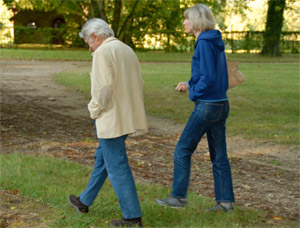
Catherine Grandsard & Tobie Nathan
medication which would finally enable her to
sleep. Over and over, she had repeated the same story: three paramilitary
Serbs had come to her village. She had been told many times how the
Serbs would kill men and rape women and when she saw the three men,
she ran away in terror. The men ran after her and caught up with her
inside a barn. There she was, faced by three men in battle fatigues,
their frightening faces smeared with black. One of them waived his hand
at the young woman and said “You, come over here…”
At that moment, she fainted. How long she had remained unconscious,
she didn’t know. What had happened during that time? Had she been
sexually abused? She couldn’t really say… Was it because
she was ashamed or had she truly forgotten? She preferred to think the
men had left her there and gone away. But ever since that day, as soon
as she fell asleep, she would see those same three frightening men approaching
her and wake up with a start, drenched in sweat. Those first scary minutes
of sleep were then followed by a long night of insomnia. The clinicians
who treated her were all convinced that during those moments she relived
the scene where she had fainted. Yet, when we set out to explore in
detail exactly what she experienced during what she referred to as her
nightmare — a violent constriction of the throat, suffocation,
burning sensations on her neck — she gradually described what
she in fact perceived. It wasn’t the paramilitary troops but a
strange sort of bird, coming down from the sky, latching on to her neck
and causing her to awaken with a start…
![]() Hence, the habit of
understanding dreams as containing precious messages about a person’s
past had kept the patient’s therapists from solliciting information
about her true perceptions. In point of fact, the young woman’s
dream contained the following information: the extreme fright caused
by the sight of the three paramilitary Serbs had fractured her being,
causing a breach in which a mythic being had engulfed itself, a strange
bird, a striga, which returned every night since then. Recognizing the
existence of this being, exploring in depth with the patient both its
nature and technical ways of getting rid of it sufficed for the young
woman to find sleep again that very same night. The reason she had not
been able to rest for so long was that her therapists had all suspended
their investigation the moment the Serbs appeared in the dream. Understanding
and treating the traumatic event at the root of traumatic symptoms is
therefore not as simple a task as it might seem. After our long interview
with the young woman, it was indeed clear that the etiology of her pathology,
the origin of the breach in her psyche, was in fact fright. But how
and why is fright the cause of disorder? As demonstrated by this particular
case, but also by many cultural etiological models of fright found worldwide,
fright evidently causes disorder because it puts human beings in the
presence of beings from other worlds.
Hence, the habit of
understanding dreams as containing precious messages about a person’s
past had kept the patient’s therapists from solliciting information
about her true perceptions. In point of fact, the young woman’s
dream contained the following information: the extreme fright caused
by the sight of the three paramilitary Serbs had fractured her being,
causing a breach in which a mythic being had engulfed itself, a strange
bird, a striga, which returned every night since then. Recognizing the
existence of this being, exploring in depth with the patient both its
nature and technical ways of getting rid of it sufficed for the young
woman to find sleep again that very same night. The reason she had not
been able to rest for so long was that her therapists had all suspended
their investigation the moment the Serbs appeared in the dream. Understanding
and treating the traumatic event at the root of traumatic symptoms is
therefore not as simple a task as it might seem. After our long interview
with the young woman, it was indeed clear that the etiology of her pathology,
the origin of the breach in her psyche, was in fact fright. But how
and why is fright the cause of disorder? As demonstrated by this particular
case, but also by many cultural etiological models of fright found worldwide,
fright evidently causes disorder because it puts human beings in the
presence of beings from other worlds.
![]() In
terms of etiology, practitioners often note two fundamental emotions
in relation to a trauma: fright and experiencing death. In fact, both
characteristics are included in the very definition of the traumatic
event in the DSM-IV [10]. Thus, a traumatized
person is first and foremost someone who has been frightened. Apparently,
the reason a new word was created in the field of psychopathology is
because the common use of the terms fear or fright had gradually lost
their physical connotations. Indeed, the emotional turmoil brought on
in a moment of great fright associates sudden and unexpected fear, a
physical startle response, an abrupt change in equilibrium, followed
by tachycardia and a physical sensation of heaviness in the stomach
or chest. The impression, when a frightened person manages to describe
the experience, is both one of loss, as if her breath had suddenly been
taken from her, and the feeling of an invasion, as though a foreign
entity had penetrated by surprise inside her system. And, just as in
the Kosovar example given above, such powerful fear is provoked when
a person is faced with the experience of her own death. Not merely the
fear of dying, but the actual living of one’s death, of an instant
where one knows one is dying or sees oneself dead.
In
terms of etiology, practitioners often note two fundamental emotions
in relation to a trauma: fright and experiencing death. In fact, both
characteristics are included in the very definition of the traumatic
event in the DSM-IV [10]. Thus, a traumatized
person is first and foremost someone who has been frightened. Apparently,
the reason a new word was created in the field of psychopathology is
because the common use of the terms fear or fright had gradually lost
their physical connotations. Indeed, the emotional turmoil brought on
in a moment of great fright associates sudden and unexpected fear, a
physical startle response, an abrupt change in equilibrium, followed
by tachycardia and a physical sensation of heaviness in the stomach
or chest. The impression, when a frightened person manages to describe
the experience, is both one of loss, as if her breath had suddenly been
taken from her, and the feeling of an invasion, as though a foreign
entity had penetrated by surprise inside her system. And, just as in
the Kosovar example given above, such powerful fear is provoked when
a person is faced with the experience of her own death. Not merely the
fear of dying, but the actual living of one’s death, of an instant
where one knows one is dying or sees oneself dead.
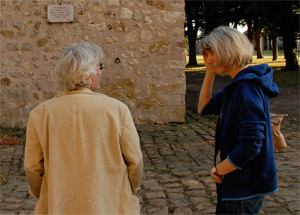
Catherine Grandsard & Tobie Nathan
the Muslim Paradise where the dead wear long
white gowns. He is X-rayed and tested: aside from several bruises, he
presents no alarming symptoms, no broken bones or hurt organs. A week
later, he is discharged from the hospital. Ever since, he suffers without
respite from splitting headaches, dizziness, nausea, whisling in the
ears, lower back pain, visual disorders and insomnia. Three years later,
the traumatic pathology which developed in the wake of his encouter
with his own death is still acute [11].
![]() Many clinicians have
encountered similar cases. Faced with the endless repetition of the
same narrative, of the same traumatic scene, what can be done? The only
way a therapist can possibly stand such a feeling of helplessness for
weeks, months and sometimes years on end — a reflection of the
patient’s experience of his own death — is by asking the
question “why?”. Why him? Why then, on that day? Because
of whom? By doing so, he or she is once more bound to witness the appearance
of beings. For instance, so and so had made love to his wife, and later
stored the towel stained with semen under the couple’s mattress,
before going to work. That evening, his wife had asked him if he had
seen the towel. He told her it was stored in the usual place, but she
couldn’t find it. Later, he had forgotten about the incident.
A week after, he had had the accident. As it turns out, his sister in
law, his wife’s brother’s wife, who lives in the same building,
had come over that day to borrow sugar. While her sister in law was
busy with a child, she had crept into the couple’s bedroom and
stolen the towel stashed under the mattress. Later that day, she had
taken it to a sorcerer who had buried it in a cemetery… The point
was to harm the couple most certainly out of spite or jealousy. This
was in fact what had happened to the Algerian immigrant worker who fell
from the scaffolding mentioned above. Now, there is only one way to
recover the towel in such a case: the man must turn to a healer, a master
of the spirits, for him to send one of his helper Djinns [12]
out into the night to retrieve the missing object and thereby save the
man from certain death.
Many clinicians have
encountered similar cases. Faced with the endless repetition of the
same narrative, of the same traumatic scene, what can be done? The only
way a therapist can possibly stand such a feeling of helplessness for
weeks, months and sometimes years on end — a reflection of the
patient’s experience of his own death — is by asking the
question “why?”. Why him? Why then, on that day? Because
of whom? By doing so, he or she is once more bound to witness the appearance
of beings. For instance, so and so had made love to his wife, and later
stored the towel stained with semen under the couple’s mattress,
before going to work. That evening, his wife had asked him if he had
seen the towel. He told her it was stored in the usual place, but she
couldn’t find it. Later, he had forgotten about the incident.
A week after, he had had the accident. As it turns out, his sister in
law, his wife’s brother’s wife, who lives in the same building,
had come over that day to borrow sugar. While her sister in law was
busy with a child, she had crept into the couple’s bedroom and
stolen the towel stashed under the mattress. Later that day, she had
taken it to a sorcerer who had buried it in a cemetery… The point
was to harm the couple most certainly out of spite or jealousy. This
was in fact what had happened to the Algerian immigrant worker who fell
from the scaffolding mentioned above. Now, there is only one way to
recover the towel in such a case: the man must turn to a healer, a master
of the spirits, for him to send one of his helper Djinns [12]
out into the night to retrieve the missing object and thereby save the
man from certain death.
![]() Thus, trauma is one
of the only modern notions for which the knowledge conveyed by traditional
cultures turns out to be decisive. A short review of the etymology of
the word fright in several languages will demonstrate how deeply such
concepts are embedded in the culture’s vocabulary [13].
Thus, trauma is one
of the only modern notions for which the knowledge conveyed by traditional
cultures turns out to be decisive. A short review of the etymology of
the word fright in several languages will demonstrate how deeply such
concepts are embedded in the culture’s vocabulary [13].
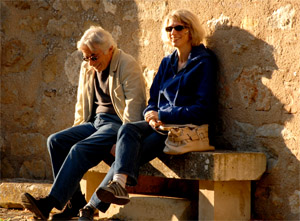
Catherine Grandsard et Tobie Nathan
Up until the 19th century, it was still a common idea in France that the mere encounter with an epileptic or with a person suffering from tics was enough to transmit to the onlooker, through fright, the same being, spirit or demon which afflicted the person. “Never look at an epileptic having a seizure because you might catch the devil”, was a common saying. But if a human being can be taken over by a being from another world, it is because his own being, his “self” — or maybe one should say his “soul” — has fled under the shock of fear.
“Gukanga, means frightened; Kwikanga means to start; Ggukangagurika means to wake up frequently while shivering, to sleep agitatedly, to be on the lookout and to start frequently. [Meanwhile,] “Igikangge refers to an invisible being found in the wilderness, marshes, chasms, bushes or the depths of the earth. Its presence can be detected through smoke rising from bushes in the early morning or evening, or through sparks in the night, or unexpected noises which sometimes resemble cattle sounds, or simply when the vegetation stirs even though there is no wind. [As in many African countries,] the swirls of dust rising from the ground at sundown also indicate the presence of the frightening spirit. People say such swirls are in fact the sign of the spirit from beneath, the sacred python on its way to the drinking trough… A sudden cold, hot or numbing feeling is also a sign. These spirits of the wilderness have their own autonomous lives and, [like the Djinns or Jnun in Arabic cultures,] they also marry, have children, raise cattle and practice the same faith as humans, namely [the traditional religion of the Barundi:] the Kubandwa possession cult… It sometimes happens that an Ibikangge or Ibihume spirit may call out someone’s name as that person passes by, at sundown or in the wee hours of the morning. He or she who answers the call risks illness, madness or even death… Skin allergies, the sudden swelling of joints, paralysis of an arm or a leg, mutism, convulsions, agitation or delusions [are often attributed to the action of these spirits]… The etiology of such pathologies is the encounter with spirits, the victim having been frightened — yarakanzwe — by his or her meeting with bush spririts such as Igikangge, Ibinyamwonga or Iggihume. Iggihume is a frightening ghost, a monster, a wild and malevolant spirit, or the spirit of a person who died a violent death and wasn’t buried and who returns to haunt the living…”
![]() Thus, in Burundi, like in many cultures around the world, the language
itself contains the theory of fright with which we are becoming familiar:
fright shatters the person’s self and thereby allows the entrance
of an invisible non human being. The pathology which ensues —
referred to as trauma, traumatic neurosis or PTSD in our own psychiatry
— is nothing other than the manifestation of the invisible being
inside the person. The therapy should then consist in expelling this
being or, at the very least, in taming it.
Thus, in Burundi, like in many cultures around the world, the language
itself contains the theory of fright with which we are becoming familiar:
fright shatters the person’s self and thereby allows the entrance
of an invisible non human being. The pathology which ensues —
referred to as trauma, traumatic neurosis or PTSD in our own psychiatry
— is nothing other than the manifestation of the invisible being
inside the person. The therapy should then consist in expelling this
being or, at the very least, in taming it.
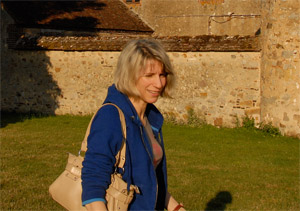
Catherine Grandsard
massacres reached the scale of genocides. Among them, the 1994 events in Rwanda remain by far the most ghastly and incomprehensible. They were triggered in the early morning of April 6, 1994 by the shooting down by ground to air missiles of the airplane carrying the president of the country as it was preparing to land at the Kigali airport, the country’s capital. The Presidential Guard and the Interahamwe, a Hutu militia under the government’s command, immediately took over and set out to carry out a plan to physically eliminate every single Tutsi living in Rwanda. Within a few weeks, the country had literally become a blood bath, river waters turning red with th blood of countless bodies, corpses by the tens of thousands littering the roads. Four months later, one eighth of the country’s population had been brutally murdered by organized mobs wielding machetes, clubs, billhooks, and less often, guns [19].
After the 1994 killings in Rwanda, the United Nations declared that Rwanda had been the site of a genocide perpetrated by the Hutu against the Tutsi, a genocide which took the lives of between eight hundred thousand and one million people. The institutional recognition of the genocide led to the creation by the Security Council of an international criminal tribunal for Rwanda (ICTR) based in Arusha, Tanzania. As for the killings in Burundi, they have yet to receive an international status. Meanwhile, noone has been judged or even accused by the extremely weak Burundian court system. Moreover, in order to downplay daily strife, amnesties have been repeatedly granted by different governments.
The following account was collected in November 2003, in the context of a training session on the psychological treatment of victims of mass trauma organized at the University of Bujumbura (Burundi) [20]. The speaker is the young man himself, whose name we have changed to Jean-Chrysostome.
“On October 21, 1993, President Ndadayé, who was a Hutu, was assassinated. For the Hutu, he was killed by the Tutsi. Groups of Hutu men set out to kill the Tutsi, barging into houses. I was at home with my brothers and we didn’t really know what was going on. Outside, a group of Tutsi men was formed but it was too small to stop the assailants. When they saw that they were too few, they ran away. I was with my brothers; there were three of us. We decided to flee in different directions. I went out into the street and I met a woman who was on her way to draw water from the well. I asked her where the killers were and when she answered me, I thought she was lying and I decided to run in another direction. I hid in the forest for the entire day. Around seven o’clock in the evening, I thought people weren’t killing anymore because of the quiet. I decided to leave the forest and to walk towards Muranza. The moment I set foot on the road, I ran into a group of thirty to forty men carrying flash lights, machetes, clubs, all sorts of things they were using to kill. They ordered me to stop but I ran into a house and locked myself inside. They followed me and broke down doors and windows. I hid inside to avoid the rocks they were throwing. They entered the house and told me to come to them. I had to obey. They searched every inch of the house; they were looking for other people but I was alone. They ordered me to step outside and once I did, they started to strike me with their machetes. They accused me of not having heeded their orders. They didn’t tie me up as they usually did so I managed to protect my head thanks to which I survived. I avoided some of the machete blows that way. They were all trying to hit me with their machetes. At one point, I heard someone say ‘be careful, don’t let him get away’ and I realized that I had to try. To my left, there were a lot of people but on the other side of me, there weren’t as many and I managed to slip through their legs. Two men ran after me. I fell once, twice and the third time they caught up with me. But one of my attackers also fell and I grabbed him by the throat and pressed as hard as I could. I also grabbed the billhook he wanted to use to kill me, but I caught it by the blade and hurt myself. I thought that if I let it go, he would retrieve it. The other guy was shouting, calling to his friends. A third guy came, he had a club and hit me on the back. I let go of the billhook and lay down on my back. One of them had a torch lamp; he realized I wasn’t dead. My heart was beating very fast. I’m not sure what happened next, but I lay there without moving and they thought I was dead. They consulted each other to decide where to dispose of my body. They looked for a latrine in which they could throw me. They were saying there shouldn’t be any trace of blood. They picked me up and carried me towards the latrine. Since I was still slightly conscious, I tried to block the entrance with my knee. The club hit me on the leg and I fell to the bottom of the latrine which was about ten to twelve meters deep. When I hit the bottom, I realized the latrine hadn’t been used yet. I was aware that I was bleeding but I didn’t know where. I had lost my shoes but not my socks so I used them to wrap around my wounds. Then I passed out. A night and an entire day went by. Towards evening, I started to dream. In my dream, I saw my friends, the ones I had been with before the whole thing started. I saw someone trying to build a house on top of me, a kind of tower, like a latrine. I called out to him, asking for help and told him I was hungry and cold but the person didn’t budge. I shouted that if I ever managed to get out of this place, he would be sorry. Then I heard a voice saying ‘take a ladder and get out of there’. But there was noone, it was still a dream. Then I saw light from the setting sun. When I reached out for the ladder and saw the light, I regained consciousness. I realized there was no ladder and that I was alone. Gradually, I realized where I was. First I thought I was in a reservoir. When I realized there was no exit, I thought maybe I could use the holes in the walls of the latrine to climb out. That’s what I did. Since I’m a Christian, I prayed to God for His help to climb out of this hole. One of my fingers had been practically torn off but part of it was still attached to my hand. I tried to tear it off completely with my teeth but I didn’t succeed. So I folded it back inside my hand. My wounds were all very painful and I used my elbows to climb. I felt dizzy so I stopped for a while, resting against my back. Then I continued to climb. When I was about to reach the top, I banged myself against some rocks and hurt my shoulder but I managed not to fall back down. Once I was out, I stood still for about five minutes, looking around me, not realizing where I was nor what had happened to me. Then I thought I needed to hide somewhere. The first building I saw was a school, run by nuns. I noticed a small group of sentries watching out for fugitives. I entered the school. I forgot to tell you that my clothes had been torn off and I was in my underwear… I was bloody and covered with mud. A nun closed the gate behind me and told me to hurry inside, but I couldn’t go any faster so she waited for me. The first thing I said was ‘I’m hungry’ But when food was brought to me, I couldn’t eat a thing. So I drank some milk first and gradually I regained some strength.”
![]() We
were a group of people in the room specially set up for consultations
at the University of Budjumbura. Among the young psychologists, several
had lived through the same events but none had been so close to death.
Everyone listened closely to Jean-Chrysostome’s story. When someone
asked him where he had found the strength to resist, he answered that
God had entered him, at the moment of the most intense fright, God who
had manifested Himself in the ladder dream and given him the strength
to climb out from the latrine. Since then, Jean-Chrysostome, both clinical
psychologist and pastor in an Evangelical church, prays and heals, guided
by the same being who appeared to him during those twenty four hours
spent at the bottom of the latrine…
We
were a group of people in the room specially set up for consultations
at the University of Budjumbura. Among the young psychologists, several
had lived through the same events but none had been so close to death.
Everyone listened closely to Jean-Chrysostome’s story. When someone
asked him where he had found the strength to resist, he answered that
God had entered him, at the moment of the most intense fright, God who
had manifested Himself in the ladder dream and given him the strength
to climb out from the latrine. Since then, Jean-Chrysostome, both clinical
psychologist and pastor in an Evangelical church, prays and heals, guided
by the same being who appeared to him during those twenty four hours
spent at the bottom of the latrine…
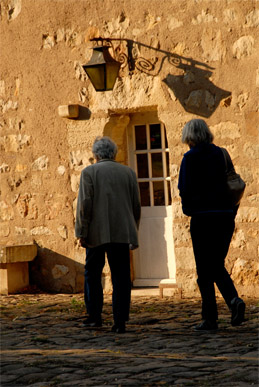
Tobie Nathan et Catherine Grandsard
Here again, the fright caused by the accident, the experience of waking up in the world of the dead, changed that. His posttraumatic symptomatology was alleviated only once the other world characteristic of his culture of origin had been recognized and he received proper expert treatment within the framework of that other, hidden world. In both these examples, as in many such cases, the traumatic event put the victims in contact with the hidden world within their respective cultural contexts. In terms of therapy, the first step towards curing this type of patient is to give credit to the non human, invisible beings recognized and described as such by the patient’s cultural tradition. In our experience, a single session is often enough to obtain significant improvement.
![]() Though
similar to the first two, Jean-Chrysostome’s case, on the other
hand, is slightly different. Following his traumatic experience, Jean-Chrysostome
did not develop posttraumatic symptoms as did our first two examples.
Quite the opposite, as a matter of fact, since after living through
his own death and resuscitation, Jean-Chrysostome took on the responsibilities
of a public figure, both a healer and a religious leader. In his case,
rather than putting him in contact with traditional invisible beings
of his cultural world, extreme fright, experiencing death and coming
back to life, forced him to contend with forces which are presently
taking over Burundi, and to actively participate in the construction
of a new social reality. In effect, Christian churches of all imaginable
denominations, as well as cults of Christian inspiration are rampant
throughout Central Africa and are currently becoming the leading political
forces in the region. Incidently, Jean-Chrysostome’s experience
suggests the ways in which the traumatic process can be — and
very often is — deliberately used as a political tool to bring
about radical transformation and set up a new world. Though in his case
he was destined to die by his agressors — the very fact that he
survived is living proof that Jesus is indeed his personal Saviour -—,
his subsequent transformation or transfiguration nevertheless clearly
demonstrates how orchestrating someone’s death and rebirth through
the use of fright can be a powerful psychological and political tool
allowing for a complete and irreversible transformation of the person.
Indeed, for this very reason, trauma is a tool well known to traditional
cultures as shown by the structure of numerous initiation rites around
the world [21]. For the same reason,
it is also a tool more and more frequently put to use by present day
radical political and religious groups.
Though
similar to the first two, Jean-Chrysostome’s case, on the other
hand, is slightly different. Following his traumatic experience, Jean-Chrysostome
did not develop posttraumatic symptoms as did our first two examples.
Quite the opposite, as a matter of fact, since after living through
his own death and resuscitation, Jean-Chrysostome took on the responsibilities
of a public figure, both a healer and a religious leader. In his case,
rather than putting him in contact with traditional invisible beings
of his cultural world, extreme fright, experiencing death and coming
back to life, forced him to contend with forces which are presently
taking over Burundi, and to actively participate in the construction
of a new social reality. In effect, Christian churches of all imaginable
denominations, as well as cults of Christian inspiration are rampant
throughout Central Africa and are currently becoming the leading political
forces in the region. Incidently, Jean-Chrysostome’s experience
suggests the ways in which the traumatic process can be — and
very often is — deliberately used as a political tool to bring
about radical transformation and set up a new world. Though in his case
he was destined to die by his agressors — the very fact that he
survived is living proof that Jesus is indeed his personal Saviour -—,
his subsequent transformation or transfiguration nevertheless clearly
demonstrates how orchestrating someone’s death and rebirth through
the use of fright can be a powerful psychological and political tool
allowing for a complete and irreversible transformation of the person.
Indeed, for this very reason, trauma is a tool well known to traditional
cultures as shown by the structure of numerous initiation rites around
the world [21]. For the same reason,
it is also a tool more and more frequently put to use by present day
radical political and religious groups.
![]() The
transforming power of trauma pertains to the cumulative aspect of the
traumatic process. If we accept the idea suggested by cultural fright
etiologies that extreme fright shatters the person, thereby putting
him in contact with beings from another, unknown world, then the primary
effect of trauma is a breakdown of the person’s former, habitual
world. In it’s place, as we have seen, a new, hidden world is
revealed. Yet, if and when this process is repeated several times, the
culturally accepted hidden or unknown world and beings, revealed by
the initial traumatic event, will in turn be shattered, putting the
victim in contact with beings and worlds previously unknown not only
to him or her but to mankind. This indeed explains the isolating effect
of cumulative trauma, the victim, gradually becoming the only person
on Earth to know of hidden worlds which noone else can see or perceive.
Thus, with each new traumatic event, the person’s usual, everyday
world loses meaning until it has become totally senseless and empty,
obligating the victim — and also his or her therapists —
to construct a “neo-world” in which the succession of events
and their implications make some sort of sense. The following account
written by an Auschwitz survivor is both a chilling and articulate description
of this process [22]. At the time of
the excerpted incident, the author has been in Auschwitz for some time
; he has run into a man he knew from Paris and followed him to his block
hoping to get some extra soup.
The
transforming power of trauma pertains to the cumulative aspect of the
traumatic process. If we accept the idea suggested by cultural fright
etiologies that extreme fright shatters the person, thereby putting
him in contact with beings from another, unknown world, then the primary
effect of trauma is a breakdown of the person’s former, habitual
world. In it’s place, as we have seen, a new, hidden world is
revealed. Yet, if and when this process is repeated several times, the
culturally accepted hidden or unknown world and beings, revealed by
the initial traumatic event, will in turn be shattered, putting the
victim in contact with beings and worlds previously unknown not only
to him or her but to mankind. This indeed explains the isolating effect
of cumulative trauma, the victim, gradually becoming the only person
on Earth to know of hidden worlds which noone else can see or perceive.
Thus, with each new traumatic event, the person’s usual, everyday
world loses meaning until it has become totally senseless and empty,
obligating the victim — and also his or her therapists —
to construct a “neo-world” in which the succession of events
and their implications make some sort of sense. The following account
written by an Auschwitz survivor is both a chilling and articulate description
of this process [22]. At the time of
the excerpted incident, the author has been in Auschwitz for some time
; he has run into a man he knew from Paris and followed him to his block
hoping to get some extra soup.
“I’m gulping the contents of a dish of soup when lightning strikes me.
A voice announces: ‘Lagersperre!’ Camp closed! Curfew!
What am I doing here? I drop the dish and race out the door.
I won’t make it this time. I’m dead. The reason is simple: I’m not in my own block in time for the curfew. For an SS, if this isn’t an attempted escape, then what is?
…I run and run and run, expecting a burst of machine gun fire from one of the miradors. Noone could avoid it. Each surveillance post watches over a sector within its range and it’s impossible to find cover. The only solution would be to throw myself against the electrified barbed wire fence.
I discover true fear. Not just anxiety, not just heightened imagination but reality. I am the prime target of all the SS machine gunmen. The only question is which one of the miradors will be the first to fire?
At that precise moment, I stopped being part of the “normal” world, acquiring my new skin: the skin of a camp prisoner [23]. Until that instant, I knew intellectually what was going on in the Lager. That evening, I lost all contact with my peers by perceiving relations between human beings from a perspective I hadn’t suspected, namely relations governed by the absence of laws. In effect, I am a solitary participant in an absurd game, the rules of which noone can master since each SS has the right to improvise according to his mood. For me, the name of the game, winner or loser, is death.
From now on, I am a Häftling, a full-fledged convict, a thing with a human face. The SS refer to deportees as a “Stück”, a piece or a part. A piece of wood or metal has value, at least commercially. The Stück I have become has no value whatsoever, be it esthetic, moral or commercial. It can be thrown away or burned. From now on, I am part of this world of spare parts. I am but a very small piece of a new world I couldn’t have imagined even though I am fitted into it.” [24].
![]() Trauma,
then, is a process whereby something happens not just to the person
but to the world itself, thereby rendering the victim permeable to new
ideas, open to the advent of a new order, in search of new meanings.
This is one of the primary dangers of cumulative trauma. Once the person
has been “opened up” by successive traumatic events, he
or she is vulnerable to all sorts of social, political, religious and
or esoteric forces and ideas, sometimes simultaneously, sometimes experimenting
one proposition after the other in an endless search for meaning. The
work of the therapist, in these cases, is to strive to both identify
and construct, together with the patient, the new world heralded by
the traumatic events and establish the patient’s place in it.
Not a simple task…
Trauma,
then, is a process whereby something happens not just to the person
but to the world itself, thereby rendering the victim permeable to new
ideas, open to the advent of a new order, in search of new meanings.
This is one of the primary dangers of cumulative trauma. Once the person
has been “opened up” by successive traumatic events, he
or she is vulnerable to all sorts of social, political, religious and
or esoteric forces and ideas, sometimes simultaneously, sometimes experimenting
one proposition after the other in an endless search for meaning. The
work of the therapist, in these cases, is to strive to both identify
and construct, together with the patient, the new world heralded by
the traumatic events and establish the patient’s place in it.
Not a simple task…
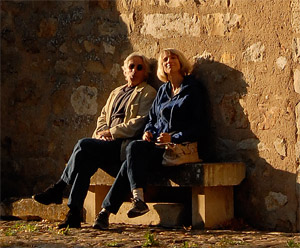
Tobie Nathan et Catherine Grandsard
true otherness, not our fellow “others”
who are in fact identical, but “others from another world”,
whose mere encounter causes a breach in our psyches, whose mere presence
petrifies us! Taken a step further, cumulative fright compels the therapist
to construct a new world for his or her traumatized patient.
![]() The Kashinawa natives
of the Amazon forest, who are aware of the advantage of producing individuals
curious about other worlds, profess a true apology of fright. They claim
that the ability to be frightened is a virtue which makes both a skilled
hunter and a skilled shaman. Indeed, a hunter needs to be keenly attuned
to the animal world and the shaman to the world of spirits [25]
and fright is the only way to introduce a person to another world. In
order to initiate their professionals to the mastery of fright, apprentices
are given a beverage called ayawaska containing juices derived from
a liana and from leaves of a specific kind of tree. The Kashinawas provide
the subtle explanation that the leaves produce the visions while the
liana makes it possible to vomit the terror produced by the visions.
The alternation between vision and regurgitation gradually confers to
the apprentice the ability to stand his beneficial fright [26].
The ability to cope with being frightened is thus equivalent to the
ability to perceive different worlds based on unknown logical principles.
This ability can be compared to the curiosity of the researcher who
has to be able to tolerate being surprised.
The Kashinawa natives
of the Amazon forest, who are aware of the advantage of producing individuals
curious about other worlds, profess a true apology of fright. They claim
that the ability to be frightened is a virtue which makes both a skilled
hunter and a skilled shaman. Indeed, a hunter needs to be keenly attuned
to the animal world and the shaman to the world of spirits [25]
and fright is the only way to introduce a person to another world. In
order to initiate their professionals to the mastery of fright, apprentices
are given a beverage called ayawaska containing juices derived from
a liana and from leaves of a specific kind of tree. The Kashinawas provide
the subtle explanation that the leaves produce the visions while the
liana makes it possible to vomit the terror produced by the visions.
The alternation between vision and regurgitation gradually confers to
the apprentice the ability to stand his beneficial fright [26].
The ability to cope with being frightened is thus equivalent to the
ability to perceive different worlds based on unknown logical principles.
This ability can be compared to the curiosity of the researcher who
has to be able to tolerate being surprised.
![]() Today, the word “fright”
is seldom used by psychopathology professionals who favor words such
as “trauma” or “stress”, yet interest is growing
in all the notions it subsumes. Recent research in the psychopathology
of trauma and in ethnopsychiatry point to its relevance and to the fact
that traditional cultures are right to hold on to it.
Today, the word “fright”
is seldom used by psychopathology professionals who favor words such
as “trauma” or “stress”, yet interest is growing
in all the notions it subsumes. Recent research in the psychopathology
of trauma and in ethnopsychiatry point to its relevance and to the fact
that traditional cultures are right to hold on to it.
![]() African Rights. Not
So Innocent: When Women Become Killers. London: African Rights, 1995.
African Rights. Not
So Innocent: When Women Become Killers. London: African Rights, 1995.
![]() Amercian Psychiatric
Association: Diagnostic and Statistical Manual of Mental Disorders,
Fourth Edition. Washington, DC, Amercian Psychiatric Association, 1994.
Amercian Psychiatric
Association: Diagnostic and Statistical Manual of Mental Disorders,
Fourth Edition. Washington, DC, Amercian Psychiatric Association, 1994.
![]() Barancira, Sylvestre.
“Théorie et traitement traditionnel de la frayeur.”
Paper presented at the Centre Culturel Français de Bujumbura,
Bujumbura, Burundi, March 30, 2004.
Barancira, Sylvestre.
“Théorie et traitement traditionnel de la frayeur.”
Paper presented at the Centre Culturel Français de Bujumbura,
Bujumbura, Burundi, March 30, 2004.
![]() Bialot, Joseph. C’est
en hiver que les jours rallongent. Paris: Le Seuil, 2002.
Bialot, Joseph. C’est
en hiver que les jours rallongent. Paris: Le Seuil, 2002.
![]() Boris, Neil W, Ou, Alan
C. and Singh, Rohini. “Preventing post-traumatic stress disorder
after mass exposure to violence.” Biosecurity and Bioterrorism:
Biodefense Strategy, Practice, and Science 3(2) (2005): 164-165.
Boris, Neil W, Ou, Alan
C. and Singh, Rohini. “Preventing post-traumatic stress disorder
after mass exposure to violence.” Biosecurity and Bioterrorism:
Biodefense Strategy, Practice, and Science 3(2) (2005): 164-165.
![]() Crocq, Louis. “Histoire
du debriefing.” Pratiques Psychologiques 10(4) (2004): 291-318.
Crocq, Louis. “Histoire
du debriefing.” Pratiques Psychologiques 10(4) (2004): 291-318.
![]() Davidson, Paul. “Eye
Movement Desensitization and Reprocessing (EMDR): A Meeta-Analysis.”
Journal of Consulting and Clinical Psychology 69(2) (2001): 305-316.
Davidson, Paul. “Eye
Movement Desensitization and Reprocessing (EMDR): A Meeta-Analysis.”
Journal of Consulting and Clinical Psychology 69(2) (2001): 305-316.
![]() Deshayes, Patrick. “Frayeurs
et visions chamaniques : le malentendu thérapeutique.”
Psychologie française 47-4 (2002): 5-14.
Deshayes, Patrick. “Frayeurs
et visions chamaniques : le malentendu thérapeutique.”
Psychologie française 47-4 (2002): 5-14.
![]() Deshayes, Patrick. “L’Ayawaska
n’est pas un hallucinogène.” Psychotropes 8 (2002):
65-78.
Deshayes, Patrick. “L’Ayawaska
n’est pas un hallucinogène.” Psychotropes 8 (2002):
65-78.
![]() Devereux, Georges. “Dedans
et dehors… la nature du stress.” Revue de Médecine
Psychosomatique et de Psychologie Médicale 2 (1966): 103-113.
Reprinted in Devereux, Georges. Ethnopsychanalyse complémentariste.
Paris: Flammarion, 1972, ch. II.
Devereux, Georges. “Dedans
et dehors… la nature du stress.” Revue de Médecine
Psychosomatique et de Psychologie Médicale 2 (1966): 103-113.
Reprinted in Devereux, Georges. Ethnopsychanalyse complémentariste.
Paris: Flammarion, 1972, ch. II.
![]() Ehlersa, Anke, and Clarka,
David. “Early Psychological Interventions for Adult Survivors
of Trauma: A Review.” Biological Psychiatry 53(9) (2003): 817-826
Ehlersa, Anke, and Clarka,
David. “Early Psychological Interventions for Adult Survivors
of Trauma: A Review.” Biological Psychiatry 53(9) (2003): 817-826
![]() Gelpin, E., Bonne O.,
Peri T., Brandes, D. and Shalev, Arieh Y. “Treatment of recent
trauma survivors with benzodiazepines: a prospective study.” Journal
of Clinical Psychiatry 57(9) (1996): 390-394.
Gelpin, E., Bonne O.,
Peri T., Brandes, D. and Shalev, Arieh Y. “Treatment of recent
trauma survivors with benzodiazepines: a prospective study.” Journal
of Clinical Psychiatry 57(9) (1996): 390-394.
![]() Hatzfeld, Jean. Dans
le nu de la vie, récits des marais rwandais. Paris: Le Seuil,
2000.
Hatzfeld, Jean. Dans
le nu de la vie, récits des marais rwandais. Paris: Le Seuil,
2000.
![]() Hatzfeld, Jean. Une
saison de machettes. Paris: Le Seuil, 2003.
Hatzfeld, Jean. Une
saison de machettes. Paris: Le Seuil, 2003.
![]() Hounkpatin, Lucien.
“Survivre au génocide… et après ?” Revue
Française de Psychosomatique 28 (2005): 99-113.
Hounkpatin, Lucien.
“Survivre au génocide… et après ?” Revue
Française de Psychosomatique 28 (2005): 99-113.
![]() Lewis, Steve. “Do
One-Shot Preventive Interventions For PTSD Work? A Systematic Research
Synthesis Of Psychological Debriefing.” Aggression and Violent
Behavior 8(3) (2003): 329-343.
Lewis, Steve. “Do
One-Shot Preventive Interventions For PTSD Work? A Systematic Research
Synthesis Of Psychological Debriefing.” Aggression and Violent
Behavior 8(3) (2003): 329-343.
![]() Nathan, Tobie. La folie
des autres. Traité d’ethnopsychiatrie. Paris: Dunod, 1986.
Nathan, Tobie. La folie
des autres. Traité d’ethnopsychiatrie. Paris: Dunod, 1986.
![]() Nathan, Tobie. L’influence
qui guérit. Paris : Odile Jacob, 1994 (reprinted in a pocket
edition in 2002).
Nathan, Tobie. L’influence
qui guérit. Paris : Odile Jacob, 1994 (reprinted in a pocket
edition in 2002).
![]() Nathan, Tobie. Nous
ne sommes pas seuls au monde. Paris: Le Seuil-Les Empêcheurs de
penser en rond, 2001.
Nathan, Tobie. Nous
ne sommes pas seuls au monde. Paris: Le Seuil-Les Empêcheurs de
penser en rond, 2001.
![]() Nathan, Tobie. “Ethnopsychiatrie,
complémentarisme, possession.” Ethnopsy: Les mondes contemporains
de la guérison 5 (2003): 7-28.
Nathan, Tobie. “Ethnopsychiatrie,
complémentarisme, possession.” Ethnopsy: Les mondes contemporains
de la guérison 5 (2003): 7-28.
![]() Nathan, Tobie. “The
Djinns: A Sophisticated Conceptualization of Pathologies and Therapies.”
In Integrating Traditional Healing Practices Into Counseling and Psychotherapy.
Edited by Roy Moodley and William West. Thousand Oaks, London, New Dehli:
Sage Publications, 2005, 26-37.
Nathan, Tobie. “The
Djinns: A Sophisticated Conceptualization of Pathologies and Therapies.”
In Integrating Traditional Healing Practices Into Counseling and Psychotherapy.
Edited by Roy Moodley and William West. Thousand Oaks, London, New Dehli:
Sage Publications, 2005, 26-37.
![]() Neumeister, Alexander.
“What role does Serotonin play in PTSD?” Psychiatric Times
23(4) (April 2006) http://psychiatrictimes.com/showArticle.jhtml?articleId=186700462
(accessed June 4, 2006).
Neumeister, Alexander.
“What role does Serotonin play in PTSD?” Psychiatric Times
23(4) (April 2006) http://psychiatrictimes.com/showArticle.jhtml?articleId=186700462
(accessed June 4, 2006).
![]() Pury-Toumi, Sybil (de).
“Une maladie nommée susto.” Nouvelle revue d’ethnopsychiatrie
15 (1990): 173-207.
Pury-Toumi, Sybil (de).
“Une maladie nommée susto.” Nouvelle revue d’ethnopsychiatrie
15 (1990): 173-207.
![]() Robertson, Michael,
Humphreys, Leanne and Ray, Rebecca. “Psychological treatments
for posttraumatic stress disorder: recommendations for the clinician
based on a review of the literature.” Journal of Psychiatric Practice
10(2) (2004): 106-118.
Robertson, Michael,
Humphreys, Leanne and Ray, Rebecca. “Psychological treatments
for posttraumatic stress disorder: recommendations for the clinician
based on a review of the literature.” Journal of Psychiatric Practice
10(2) (2004): 106-118.
![]() Sin Chan, Ernest. “Une
étiologie traditionnelle chez les Hakka de Polynésie française
: le hak tao ou la théorie étiologique de la frayeur.”
Ethnopsy: Les mondes contemporains de la guérison 5 (2003): 181-207.
Sin Chan, Ernest. “Une
étiologie traditionnelle chez les Hakka de Polynésie française
: le hak tao ou la théorie étiologique de la frayeur.”
Ethnopsy: Les mondes contemporains de la guérison 5 (2003): 181-207.
![]() Taylor, Steven, Thordarson,
Dana S., Maxfield, Louise, Fedoroff, Ingrid C., Lovell, Karina, and
Ogrodniczuk. “Comparative efficacy, speed, and adverse effects
of three PTSD treatments: exposure therapy, EMDR, and relaxation training.”
Journal of Consulting and Clinical Psychology 71(2) (2003): 330-338.
Taylor, Steven, Thordarson,
Dana S., Maxfield, Louise, Fedoroff, Ingrid C., Lovell, Karina, and
Ogrodniczuk. “Comparative efficacy, speed, and adverse effects
of three PTSD treatments: exposure therapy, EMDR, and relaxation training.”
Journal of Consulting and Clinical Psychology 71(2) (2003): 330-338.
![]() Van Emmerik, Arnold,
Kamphuis, Jan H., Hulsbosch, Alexander M., and Emmelkamp, Paul MG. “Single
session debriefing after psychological trauma: a meta-analysis.”
The Lancet 260(9335) (2002): 766-771.
Van Emmerik, Arnold,
Kamphuis, Jan H., Hulsbosch, Alexander M., and Emmelkamp, Paul MG. “Single
session debriefing after psychological trauma: a meta-analysis.”
The Lancet 260(9335) (2002): 766-771.
![]() Vermeiren, Etienne,
and De Clercq, Michel. “Le debriefing psychologique après
un événement à caractère traumatique: intérêts
et limites. Médecines de catastrophe-Urgences collectives 2(3-4)
(1999): 95-99.
Vermeiren, Etienne,
and De Clercq, Michel. “Le debriefing psychologique après
un événement à caractère traumatique: intérêts
et limites. Médecines de catastrophe-Urgences collectives 2(3-4)
(1999): 95-99.
![]() Watson, P., Friedman,
M., Ruzek J., and Norris, F. “Managing acute stress response to
major trauma.” Current Psychiatry Reports 4(4) (2002): 247-253.
Watson, P., Friedman,
M., Ruzek J., and Norris, F. “Managing acute stress response to
major trauma.” Current Psychiatry Reports 4(4) (2002): 247-253.
![]() Zajde, Nathalie. “Le
traumatisme.” Psychothérapies. Edited by Tobie Nathan.
Paris: Odile Jacob, 1998, 223-279.
Zajde, Nathalie. “Le
traumatisme.” Psychothérapies. Edited by Tobie Nathan.
Paris: Odile Jacob, 1998, 223-279.
![]() Zajde, Nathalie. Enfants
de survivants. Paris: Odile Jacob, 1993 (reprinted in 2005).
Zajde, Nathalie. Enfants
de survivants. Paris: Odile Jacob, 1993 (reprinted in 2005).
![]() Zajde, Nathalie, and
Grandsard, Catherine. “Kaddish. Rituel de deuil dans un groupe
de parole d’enfants de survivants de la Shoah.” Nouvelle
revue d’ethnopsychiatrie 31 (1996): 119-138.
Zajde, Nathalie, and
Grandsard, Catherine. “Kaddish. Rituel de deuil dans un groupe
de parole d’enfants de survivants de la Shoah.” Nouvelle
revue d’ethnopsychiatrie 31 (1996): 119-138.
![]() Zajde, Nathalie, and
Grandsard, Catherine. “Le groupe de parole d’enfants de
victimes de la Shoah: un dipositif de recherche en psychologie clinique.”
Psychologie française, 47 (2002): 73-83.
Zajde, Nathalie, and
Grandsard, Catherine. “Le groupe de parole d’enfants de
victimes de la Shoah: un dipositif de recherche en psychologie clinique.”
Psychologie française, 47 (2002): 73-83.
![]() Zajde, Nathalie. Guérir
de la Shoah. Paris: Odile Jacob, 2005.
Zajde, Nathalie. Guérir
de la Shoah. Paris: Odile Jacob, 2005.
[1].
Paper presented at the Third International Trauma Research Net Conference,
Trauma-Stigma and Distinction: Social Ambivalences in the Face of Extreme
Suffering, St Moritz, 14-17 September 2006.
[2]. Full Professor of Clinical Psychology
and Psychopathology, founder of the Georges Devereux Center at the University
of Paris 8, and currently Cultural Counsellor at the French Embassy in
Israel.
[3]. Family Therapist, Associate Professor
of Clinical Psychology and Psychopathology, Adjunct director of the Georges
Devereux Center, University of Paris 8, 2 rue de la liberté, 93526
Saint-Denis, France, website: www.ethnopsychiatrie.net
[4]. Neumeister, Alexander. “What
Role Does Serotonin Play In PTSD?” Psychiatric Times 23(4) (April
2006) (accessed June 4, 2006). See also Gelpin, E., Bonne O., Peri T.,
Brandes, D. and Shalev, A. Y. “Treatment of Recent Trauma Survivors
with Benzodiazepines: A Prospective Study.” Journal of Clinical
Psychiatry 57(9) (1996): 390-394.
[5]. For example Van Emmerik, Arnold, Kamphuis,
Jan H., Hulsbosch, Alexander M., and Emmelkamp, Paul MG. “Single
Session Debriefing After Psychological Trauma: A Meta-Analysis.”
The Lancet 260(9335) (2002): 766-771; Taylor, Steven, Thordarson, Dana
S., Maxfield, Louise, Fedoroff, Ingrid C., Lovell, Karina, and Ogrodniczuk.
“Comparative Efficacy, Speed, And Adverse Effects Of Three PTSD
Treatments: Exposure Therapy, EMDR, And Relaxation Training.” Journal
of Consulting and Clinical Psychology 71(2) (2003): 330-338.
[6]. Devereux, Georges. “Dedans et
dehors… la nature du stress.” Revue de Médecine Psychosomatique
et de Psychologie Médicale 2 (1966): 103-113. Reprinted in Devereux,
Georges. Ethnopsychanalyse complémentariste. Paris: Flammarion,
1972, ch. II.
[7]. See diagnostic criterion A in the
DSM-IV for both Posttraumatic Stress Disorder and Acute Stress Disorder
: “The person has been exposed to a traumatic event in which both
of the following were present:
(1) the person experienced, witnessed, or was confronted with an event or events that involved actual or threatened death or serious injury, or a threat to the physical integrity of self or others
(2) the person’s response involved intense fear, helplessness, or horror.” (Quoted from Amercian Psychiatric Association: Diagnostic and Statistical Manual of Mental Disorders, Fourth Edition. Washington, DC, Amercian Psychiatric Association, 1994, 427-428.)
[8]. See for example : Boris, Neil W, Ou,
Alan C. and Singh, Rohini. “Preventing Post-Traumatic Stress Disorder
After Mass Exposure To Violence.” Biosecurity and Bioterrorism:
Biodefense Strategy, Practice, and Science 3(2) (2005): 164-165 ; Crocq,
Louis. “Histoire du debriefing.” Pratiques Psychologiques
10(4) (2004): 291-318; Davidson, Paul. “Eye Movement Desensitization
and Reprocessing (EMDR): A Meeta-Analysis.” Journal of Consulting
and Clinical Psychology 69(2) (2001): 305-316 ; Ehlersa, Anke, and Clarka,
David. “Early Psychological Interventions for Adult Survivors of
Trauma: A Review.” Biological Psychiatry 53(9) (2003): 817-826 ;
Lewis, Steve. “Do One-Shot Preventive Interventions For PTSD Work?
A Systematic Research Synthesis Of Psychological Debriefing.” Aggression
and Violent Behavior 8(3) (2003): 329-343; Robertson, Michael, Humphreys,
Leanne and Ray, Rebecca. “Psychological Treatments For Posttraumatic
Stress Disorder: Recommendations For The Clinician Based On A Review Of
The Literature.” Journal of Psychiatric Practice 10(2) (2004): 106-118
; Watson, PJ, Friedman, MJ, Ruzek, Josef, and Norris, F. “Managing
Acute Stress Response To Major Trauma.” Current Psychiatry Reports
4(4) (2002): 247-253 ; Vermeiren, Etienne, and De Clercq, Michel. “Le
debriefing psychologique après un événement à
caractère traumatique: intérêts et limites. Médecines
de catastrophe-Urgences collectives 2(3-4) (1999): 95-99.
[9]. Tobie Nathan. See Nathan, Tobie. Nous
ne sommes pas seuls au monde. Paris: Le Seuil-Les Empêcheurs de
penser en rond, 2001.
[10]. See above, note 2.
[11]. This case and its treatment were
described in Nathan, Tobie. La folie des autres. Traité d’ethnopsychiatrie.
Paris: Dunod, 1986.
[12]. In the Muslim tradition, the Djinns
are invisible spirits who live alongside humans. See Nathan, Tobie. “The
Djinns: A Sophisticated Conceptualization of Pathologies and Therapies.”
In Integrating Traditional Healing Practices Into Counseling and Psychotherapy.
Edited by Roy Moodley and William West. Thousand Oaks, London, New Dehli:
Sage Publications, 2005, 26-37.
[13]. See also Nathan, Tobie. L’influence
qui guérit. Paris: Odile Jacob, 1994, reprinted in a pocket edition
in 2002.
[14]. See Nathan, Tobie. “Ethnopsychiatrie,
complémentarisme, possession.” Ethnopsy: Les mondes contemporains
de la guérison 5 (2003): 7-28.
[15]. This disorder is so common that
it was introduced in the DSM-IV. See also Pury-Toumi, Sybil (de). “Une
maladie nommée susto.” Nouvelle revue d’ethnopsychiatrie
15 (1990): 173-207.
[16]. Sin Chan, Ernest. “Une étiologie
traditionnelle chez les Hakka de Polynésie française : le
hak tao ou la théorie étiologique de la frayeur.”
Ethnopsy: Les mondes contemporains de la guérison 5 (2003): 181-207.
[17].Barancira, Sylvestre. “Théorie
et traitement traditionnel de la frayeur.” Paper presented at the
Centre Culturel Français de Bujumbura, Bujumbura, Burundi, March
30, 2004.
[18]. Large scale massacres occurred
in 1959, 1962, 1965, 1972, 1988, 1992, 1993 and of course 1994. See Guichaoua,
André. “Zoom sur… Les crises de la région des
Grands Lacs”, Politique Africaine 68 (1997): 11-22.
[19].See African Rights. Not So Innocent:
When Women Become Killers. London: African Rights, 1995. See also Hatzfeld,
Jean. Dans le nu de la vie, récits des marais rwandais. Paris:
Le Seuil, 2000 and Une saison de machettes. Paris: Le Seuil, 2003.
[20].See Hounkpatin, Lucien. “Survivre
au génocide… et après ?” Revue Française
de Psychosomatique 28 (2005): 99-113.
[21]. See Zajde, Nathalie. “Le
traumatisme.” Psychothérapies. Edited by Tobie Nathan. Paris:
Odile Jacob, 1998, 223-279.
[22]. On ethnopsychiatry and Holocaust
survivors and their offspring, see Zajde, Nathalie. Guérir de la
Shoah. Paris: Odile Jacob, 2005. See also Zajde, Nathalie. Enfants de
survivants. Paris: Odile Jacob, 1993 (reprinted in 2005); Zajde, Nathalie,
and Grandsard, Catherine. “Kaddish. Rituel de deuil dans un groupe
de parole d’enfants de survivants de la Shoah.” Nouvelle revue
d’ethnopsychiatrie 31 (1996): 119-138 ; Zajde, Nathalie, and Grandsard,
Catherine. “Le groupe de parole d’enfants de victimes de la
Shoah: un dipositif de recherche en psychologie clinique.” Psychologie
française, 47 (2002): 73-83.
[23]. In French : déporté
[24]. Bialot, Joseph. C’est en
hiver que les jours rallongent. Paris: Le Seuil, 2002, 67-68. Quote translated
from the French by Catherine Grandsard.
[25]. Deshayes, Patrick. “Frayeurs
et visions chamaniques : le malentendu thérapeutique.” Psychologie
française 47-4 (2002): 5-14.
[26]. Deshayes, Patrick. “L’Ayawaska
n’est pas un hallucinogène.” Psychotropes 8 (2002):
65-78.
